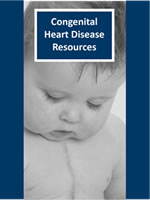Children and Youth with Special Health Needs (CYSHN)
Programs
Contact Info
Tricuspid Valve Atresia and Stenosis
Condition Description
Tricuspid valve atresia is a defect of the heart that occurs in the early weeks of fetal life for an unknown reason. The tricuspid valve fails to develop so blood is unable to enter the right ventricle and that ventricle does not develop normally. The right ventricle is very small. The small right ventricle is supplied with blood through a hole in the heart's wall from the left ventricle (called a ventricular septal defect, VSD). The baby will also have a hole between the upper pumping chambers of the heart (an atrial septal defect, or ASD). Babies will also have an underdeveloped pulmonary artery and valve within that artery (pulmonary valve). Blood will typically return to the lungs through a pulmonary artery that comes from the aorta (truncus arteriosus) or through another vessel such as the ductus arteriosus. There is a right to left shunt through the ASD, resulting in blood that lacks oxygen going out to the body and to the brain. The baby will have a grayish-blue color from the low oxygen (called cyanosis).
Typically, the child will have a number of other heart-related defects in addition to the absence of the tricuspid valve and small ventricle. These might include pulmonary atresia (very small pulmonary artery), pulmonary stenosis (narrowing of the pulmonary artery), ventricular septal defect (VSD, a hole between the two lower pumping chambers, the ventricles), or subaortic stenosis (narrowing of the aorta as it leaves the heart chamber).
Tricuspid stenosis is an obstruction or narrowing of the tricuspid valve, which may restrict blood flow from the right atrium to the right ventricle. Over time the right atrium can become enlarged because blood flow through the narrow tricuspid valve is partially blocked. An enlarged atrium can affect the pressure and blood flow in the nearby chambers of the heart. Tricuspid stenosis is usually an effect of having rheumatic fever.
Children with tricuspid atresia and stenosis will need to be followed long-term by cardiologists to be sure that any complications or new conditions are quickly detected and treated.
Our program has been tracking tricuspid valve atresia and stenosis among live births in select counties since 2005 and gradually expanded statewide.
- Using data from births statewide between 2016-2020, we found that approximately 1 baby was born with tricuspid valve atresia and stenosis per 10,000 births.
- Using this data, we estimate about 9 babies are born with tricuspid valve atresia and stenosis every year in Minnesota.
